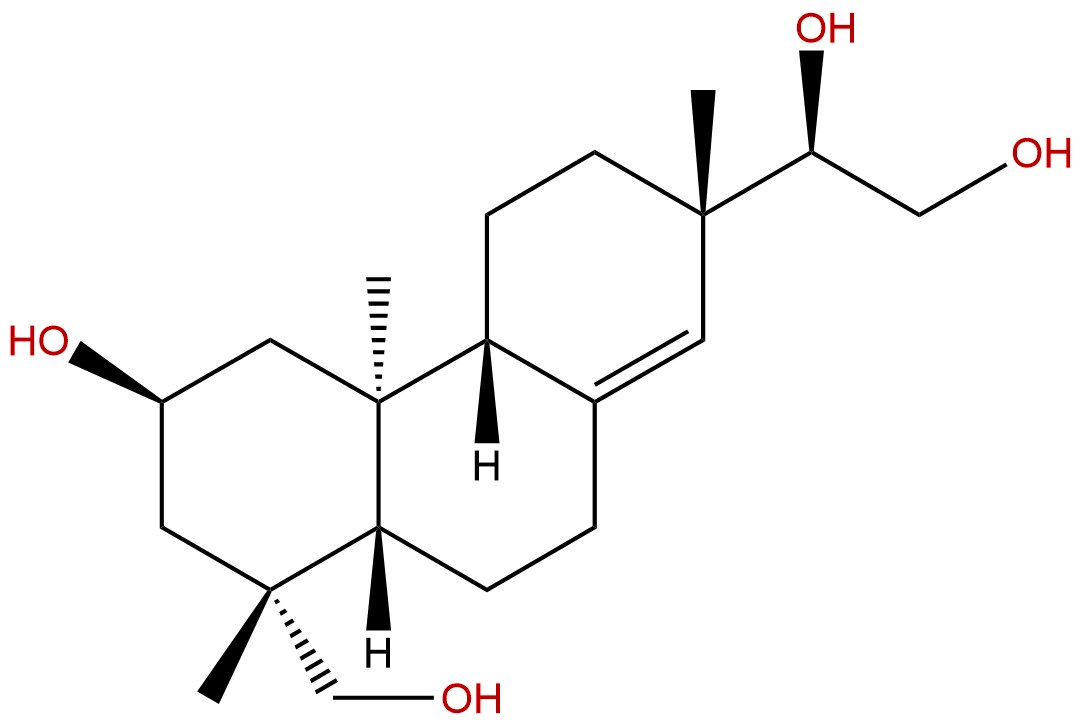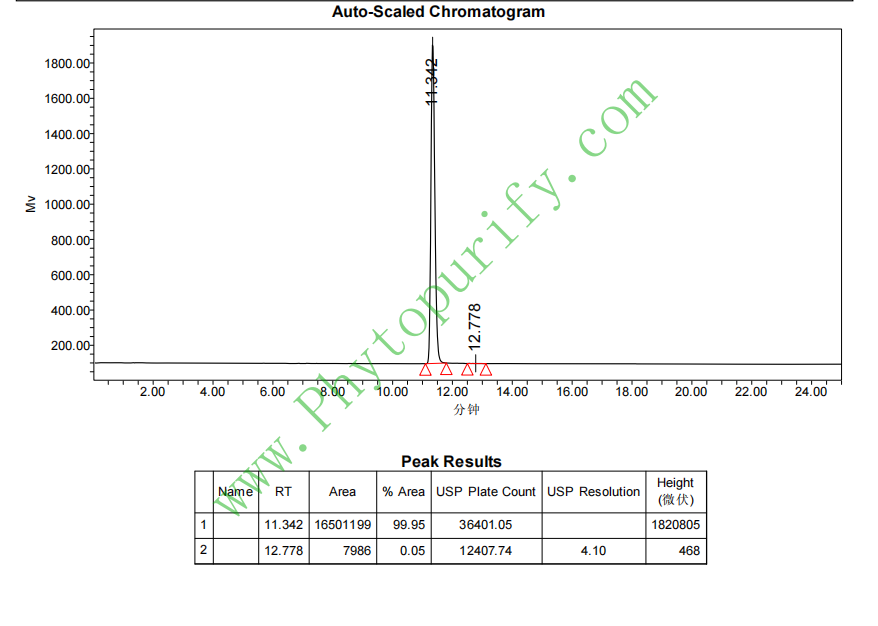
KirenolCAS No.:52659-56-0
|
||||||||||
 |
|
|
||||||||

| Catalogue No.: | BP0831 |
| Formula: | C20H34O4 |
| Mol Weight: | 338.488 |
Synonym name:
Catalogue No.: BP0831
Cas No.: 52659-56-0
Formula: C20H34O4
Mol Weight: 338.488
Botanical Source: Siegesbeckia pubescens and Siegesbeckia glabrescens
Purity: 95%~99%
Analysis Method: HPLC-DAD or/and HPLC-ELSD
Identification Method: Mass, NMR
Packing: Brown vial or HDPE plastic bottle
Can be supplied from milligrams to grams.
For Reference Standard and R&D, Not for Human Use Directly.
Inquire for bulk scale.
Description:
Kirenol possesses anti-bacteria, immunosuppression, anti-obesity, anti-oxidant, anti-inflammatory, anti-allergic, and anti-arthritic activities. Kirenol has significant potential for its discovery as a new lead compound for management of topical pain and inflammation; it can upregulate nuclear Annexin-1 which interacts with NF-κB to attenuate synovial inflammation of collagen-induced arthritis in rats. Kirenol can attenuate experimental autoimmune encephalomyelitis by inhibiting differentiation of Th1 and th17 cells and inducing apoptosis of effector T cells. Kirenol activates the BMP and Wnt/β-catenin signaling pathways.
References:
Sci Rep. 2015 Mar 12;5:9022.
Kirenol attenuates experimental autoimmune encephalomyelitis by inhibiting differentiation of Th1 and th17 cells and inducing apoptosis of effector T cells.
Experimental autoimmune encephalomyelitis (EAE), a model of multiple sclerosis (MS), is characterized by CNS demyelination mediated by autoreactive T cells. Kirenol, a biologically active substance isolated from Herba Siegesbeckiae, has potent anti-inflammatory activities.
METHODS AND RESULTS:
Here we investigated effects of Kirenol on EAE. Kirenol treatment markedly delayed onset of disease and reduced clinical scores in EAE mice. Kirenol treatment reduced expression of IFN-γ and IL-17A in the serum and proportion of Th1 and Th17 cells in draining lymph nodes. Priming of lymphocytes was reduced and apoptosis of MOG-activated CD4+ T cells was increased in Kirenoltreated EAE mice. Kirenol treatment of healthy animals did not affect the lymphocytes in these non-immunized mice. Further in vitro studies showed that Kirenol inhibited viability of MOG-specific lymphocytes and induced apoptosis of MOG-specific CD4+ T cells in a dose- and time-dependent manner. Kirenol treatment upregulated Bax,downregulated Bcl-2,and increased activation of caspase-3 and release of cytochrome c, indicating that a mitochondrial pathway was involved in Kirenol induced apoptosis. Moreover, pretreatment with either a pan-caspase inhibitor z-VAD-fmk or a more specific caspase 3 inhibitor Ac-DEVD-CHO in lymphocytes reduced Kirenol induced apoptosis.
CONCLUSIONS:
Our findings implicate Kirenol as a useful agent for the treatment of MS.
Pharmacogn Mag. 2012 Apr;8(30):149-55.
Kirenol production in hairy root culture of Siegesbeckea orientalis and its antimicrobial activity.
Despite the excellent anti-inflammatory and anti-rheumatic efficacy associated with Kirenol generation, the content of Kirenol in Siegesbeckea orientalis is quite low. This study was designed to establish a reliable Kirenol production protocol by transformed root cultures of S. orientalis and to investigate the antimicrobial activities of Kirenol, hairy root, and S. orientalis.
METHODS AND RESULTS:
Transformed root cultures of S. orientalis were established by the transformation of Agrobacterium rhizogenes A4. Transgenic status of the roots was confirmed by polymerase chain reaction (PCR) using rolB specific primers. The biomass and Kirenol accumulation of hairy root clones were assessed using four different culture media: MS, MS/2, B5, and white. The antimicrobial activities of Kirenol, hairy root, and S. orientalis were evaluated by the disc diffusion method. The optimum media for Kirenol synthesis was MS. The content of Kirenol in transformed hairy roots made up about 80% of that observed in natural leaves of S. orientalis (1.6 mg/g dry weight). All tested samples displayed antimicrobial activity against Gram-positive pathogens including Staphylococcus epidermidis, Staphylococcus aureus, and Acinetobacter baumannii, with MIC ranging from 78 to 625 μg/mL.
CONCLUSIONS:
The high level of Kirenol contents was obtained from hairy roots of S. orientalis. Kirenol was effective against gram-positive bacteria. Interestingly, the extract from hairy roots showed a diverse antimicrobial effect from that of Kirenol and S. orientalis.
J Ethnopharmacol. 2011 Oct 11;137(3):1089-94.
Topical anti-inflammatory and analgesic activity of kirenol isolated from Siegesbeckia orientalis.
Siegesbeckia orientalis has been traditionally used as a topical anti-inflammatory and analgesic agent. Current study was designed to explore the topical anti-inflammatory and analgesic effects of a constituent isolated from Siegesbeckia orientalis (Compositae), in order to validate its folk use.
METHODS AND RESULTS:
Kirenol was isolated from ethanolic extract of Siegesbeckia orientalis. Several topical formulations containing Kirenol were investigated for anti-inflammatory and analgesic activities in rat. The effects were studied using carrageenan-induced rat acute inflammation model, complete Freund's adjuvant (CFA)-induced chronic inflammation and formalin test in rats. Piroxicam gel and methyl salicylate ointment were studied as positive control for anti-inflammatory and analgesic activity, respectively. The anti-inflammatory effect of Kirenol 0.4-0.5% (w/w) was similar to the effect of piroxicam gel 4h after carrageenan injection. The analgesic activity of topical preparation with more than 0.4% (w/w) was observed in the late phase. These effects may be due, at least in part, to the pro-inflammatory cytokine production of IL-1β and TNF-α. The administration of Kirenol cream at the dose of 0.3, 0.4 and 0.5% (w/w) significantly inhibited the development of joint swelling induced by CFA, which was auxiliary supported by histopathological studies.
CONCLUSIONS:
Kirenol has demonstrated its significant potential to be further investigated for its discovery as a new lead compound for management of topical pain and inflammation, although further pharmacological research is necessary to fully understand its mechanism of action. It also supports the potential beneficial effect of topically administered Siegesbeckia orientalis in inflammatory diseases.
Phytomedicine. 2012 Jul 15;19(10):882-9.
Kirenol exerts a potent anti-arthritic effect in collagen-induced arthritis by modifying the T cells balance.
Rheumatoid arthritis is characterized by the imbalance of T cells, which leads to increased pro-inflammatory and reduced anti-inflammatory cytokines. Modulating the balance among T cells is crucial for the treatment of RA. Kirenol is a major diterpenoid components of Herba Siegesbeckiae, which has been applied for arthritic therapy for centuries. Since prior research showed Kirenolexhibited anti-inflammatory effect in rats, in this study we have evaluated the effect and mechanism of bioactive Kirenol in a rat model of collagen-induced arthritis (CIA) on modulation of T cells.
METHODS AND RESULTS:
After immunization with bovine type II collagen (CII), Wistar rats were orally administered saline (CIA group), 2 mg/kg Kirenol or 2 mg/kg prednisolone daily for 30 days. The severity of arthritis was clinically and histologically assessed. The numbers of CD4⁺CD25⁺Foxp3⁺ T regulatory cells (Tregs) and IFNγ⁺CD4⁺ and IL4⁺CD4⁺ T cells were determined by flow cytometry, the mRNA expression level of Foxp3 was quantified by RT-PCR, cytokine levels were measured by ELISA and CII-induced cell proliferation was quantified in vitro. Kirenol significantly delayed the occurrence and reduced the disease severity of CIA. Histological analysis confirmed Kirenol suppressed joint inflammation and inhibited cartilage and bone destruction, compared to the CIA group. Kirenol also upregulated the mRNA expression of Foxp3, increased the numbers of CD4⁺CD25⁺Foxp3⁺ and IL4⁺CD4⁺ T cells, and reduced the number of IFNγ⁺CD4⁺ T cells. Kirenol reduced the levels of TNF-α, IL-17A and IL-6 in synovial fluid and TNF-α, IL-17A and IFN-γ in serum, and increased the serum levels of IL-4, IL-10 and TGF-β1. In addition, Kirenol inhibited the ability of CII to induce splenocyte, PBMC and lymph node cell proliferation in vitro, compared to cells from CIA rats.
CONCLUSIONS:
In conclusion, these results suggest that Kirenol may be a potential immunosuppressant for the treatment for rheumatoid arthritis.
HPLC of Kirenol
